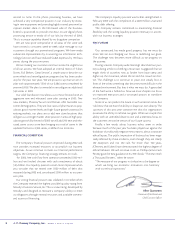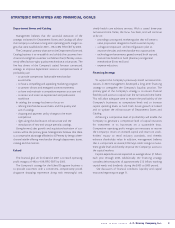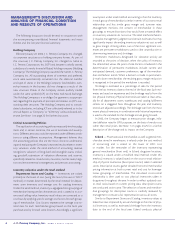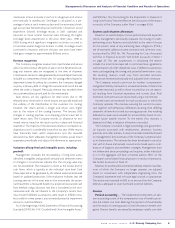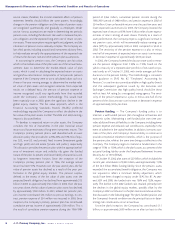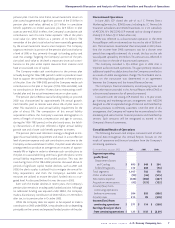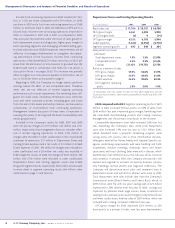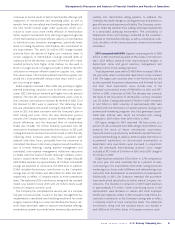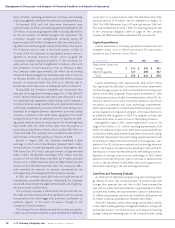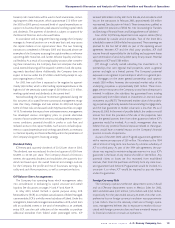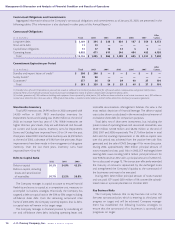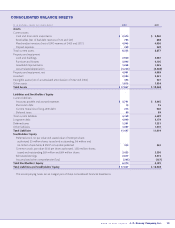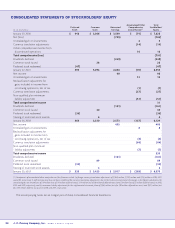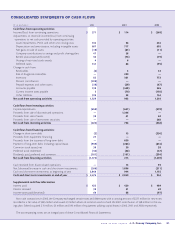JCPenney 2002 Annual Report Download - page 15
Download and view the complete annual report
Please find page 15 of the 2002 JCPenney annual report below. You can navigate through the pages in the report by either clicking on the pages listed below, or by using the keyword search tool below to find specific information within the annual report.
J. C. Penney Company, Inc. 2002 annual report12
Management’s Discussion and Analysis of Financial Condition and Results of Operations
result of better operating performance, inventory and working
capital management, and lower than planned capital expenditures.
At year-end 2002, cash and short-term investments were
approximately $2.5 billion, representing approximately 46% of the
$5.4 billion of outstanding long-term debt including $200 million
for the securitization of Eckerd managed care receivables. The
Company’s liquidity was strengthened, including paying off
approximately $920 million of long-term debt that matured dur-
ing 2002 and contributing $300 million ($190 million after tax) to
the Company’s pension plan in the fourth quarter of 2002. In
October 2002, the Company’s strong liquidity position was rec-
ognized by Moody’s Investors Service, which assigned the
Company its highest liquidity rating (SGL-1). The Company’s liq-
uidity position was further strengthened in February 2003 with
the completion of two transactions. First, on February 3, 2003,
the Company raised approximately $50 million by securitizing
additional Eckerd managed care receivables (See Note 5). Second,
on February 28, 2003, the Company issued $600 million principal
amount of unsecured Notes Due 2010 at an effective rate of
8.125%. See further discussion of subsequent events in Note 21.
During 2002, the Company completed two transactions that
were part of its long-term financing strategy. First, in May 2002, JCP
and J.C. Penney Company, Inc. executed a new three-year $1.5 bil-
lion revolving credit agreement (credit facility), which replaced a
$1.5 billion bank revolving credit facility and a $630 million letter of
credit facility. Indebtedness incurred under the credit facility is col-
lateralized by all eligible domestic department store and catalog
inventory, as defined in the credit facility agreement. This credit
facility provides JCP with an additional source of liquidity for work-
ing capital needs and letter of credit support. No borrowings have
been made under this credit facility, other than the issuance of
trade and stand-by letters of credit, which totaled $206 million as
of year-end 2002. The Company was in compliance with all finan-
cial covenants of the credit facility as of January 25, 2003.
Second, in August 2002, the Company completed a debt
exchange in which certain bondholders tendered $227.2 million
principal amount of three existing debt issues in exchange for new
9.0% Notes Due 2012 with a principal amount of approximately
$230.2 million. Bondholders exchanged $79.4 million principal
amount of JCP’s 6.125% Notes Due 2003, $67.0 million principal
amount of its 7.375% Notes Due 2004 and $80.8 million principal
amount of its 6.9% Debentures Due 2026. This transaction effec-
tively extended the maturity on amounts represented by the
exchanged notes and strengthened the Company’s liquidity.
In 2001, the Company issued $650 million principal amount of
subordinated convertible debentures. Additionally, the Company
securitized certain Eckerd managed care receivables, which generat-
ed cash proceeds of $200 million.
The Company’s liquidity is enhanced by the fact that the cur-
rent debt portfolio and material lease agreements do not contain
any provisions that could trigger early payments, acceleration or
collateral support in the event of adverse changes in the
Company’s financial condition.
The Company has two debenture series that contain put options.
In each case, the investor may elect to have the debenture redeemed
at par prior to its stated maturity date. The 6.9% Notes Due 2026,
principal amount $119 million, may be redeemed on August 15,
2003. The 7.4% Debentures Due 2037, principal amount $400 mil-
lion, may be redeemed on April 1, 2005. For planning purposes, and
in the contractual obligations table on page 14, the Company
assumes the debenture holders will exercise their put options.
Capital Expenditures
Capital expenditures, including capitalized software costs and
intangible assets, such as Eckerd prescription file acquisitions,
during the past three years are as follows:
($ in millions) 2002 2001 2000
Department Stores and
Catalog $ 317 $ 332 $ 361
Eckerd Drugstores 341 299 317
Tot al $ 658 $ 631 $ 678
Capital expenditures were approximately $200 million below
the original plan for 2002 due to the deferral of certain department
store technology projects as well as increased lease financing avail-
able for new Eckerd drugstores. Major capital investments in 2002
for department stores included the implementation of the SSC dis-
tribution network and in-store centralized checkouts, store mod-
ernizations and renewals and store technology improvements.
2002 capital investments in Eckerd were made primarily to contin-
ue the drugstore reconfiguration program, which was rolled out to
an additional 800 drugstores in 2002. This program includes new
and relocated stores, as well as stores in freestanding locations.
Management expects 2003 capital expenditures to be in the
range of $0.9 billion to $1.1 billion, including approximately $100
million for deferred projects from 2002. 2003 capital expenditures
will be about evenly split between Department Stores and Catalog,
and Eckerd. Department Store and Catalog capital investments will
be primarily for department store renovations and upgrades, com-
pletion of the SSC distribution network and technology enhance-
ments. The majority of Eckerd capital spending in 2003 will be for
the expansion of new and relocated stores, remodeling and recon-
figuration of existing stores and new technology. In 2003, Eckerd
expects to remodel 550 stores, open or relocate an additional 250
stores, so that by the end of 2003, 80% of the total drugstore port-
folio will be operating in the new reconfigured format.
Cash Flow and Financing Outlook
As of the end of 2002, the Company’s long-term financing strate-
gy remains on track. Two consecutive years of positive results and
stronger than expected free cash flow in 2002 have increased the
cash and short-term investment balance to approximately $2.5 billion
as of year end. In effect, the cash investment balance is comprised of
$1.3 billion of positive free cash flow over the 2000 to 2002 period and
$1.1 billion in after-tax proceeds from the 2001 sale of DMS.
With the Company’s current credit ratings and increased volatility
in the capital markets generally, management believes a strong cash
and liquidity position is an important part of its long-term financing
strategy during the remaining years of the turnaround plan. Going


